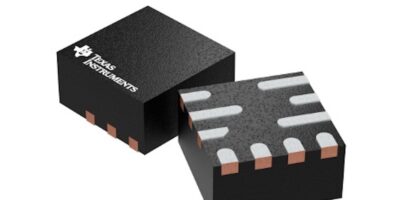Low noise buck converters are engineered to simplify high precision designs
High-efficiency operation can be achieved for noise-sensitive applications, says Texas Instruments, using its latest low noise, low ripple buck converters.
The TPS62912 and TPS62913 are a family of low-noise DC/DC switching regulators with integrated ferrite bead compensation. They offer low noise of 20 microV RMS for frequencies ranging from 100Hz to 100kHz and low output voltage ripple of 10 microV RMS. Engineers can use them in a design to remove one or more low-dropout regulators (LDOs), reduce power losses by up to 76 per cent and save 36 per cent of board space.
Noise in a power supply is proving a significant design challenge in many high-precision test and measurement, medical, aerospace and defence, and wireless infrastructure applications. A traditional low-noise power-supply architecture includes a DC/DC converter, a low noise LDO and an off-chip filter, such as a ferrite bead. By integrating ferrite-bead compensation, the TPS62912 and TPS62913 use the ferrite bead already present in most systems as an effective filter against high frequency noise. The power supply output voltage ripple is reduced by approximately 30dB. The design of the power supply is also simplified, notes Texas Instruments.
The TPS62912 and TPS62913 offer supply rails with low noise and low ripple, essential to preserve signal accuracy and integrity in high precision systems. They also have a power supply rejection ratio of 65dB at up to 100kHz. Output voltage error is less than one per cent, which helps ensure tight output voltage accuracy. Both converters enable the use of spread spectrum frequency modulation to attenuate radio-frequency spurs and allow synchronisation to an external clock so engineers can meet their signal-to-noise ratio (SNR) and spurious-free dynamic range (SFDR) targets, in applications such as medical imaging or radar.
Peak efficiency of 97 per cent allows engineers to design for noise filtering without an LDO, reducing power losses (1.8W in analogue front end (AFE) designs and 1.5W in designs using a wideband ADC). This represents a 20 and 15 per cent increase in efficiency, respectively, says TI, when compared to a traditional low-noise power architecture.
The TPS62912 and TPS62913 eliminate the linear regulator and also the associated passive components, which can save approximately 20mm2 of PCB area per LDO, TI reports. Designs that typically use a single LDO can save 36 per cent of PCB space and the integrated ferrite bead compensation of the buck converters helps engineers reduce the overall DC/DC component count, eliminating two capacitors and two resistors, to minimise system cost and shorten design time.
Pre-production quantities of the 2.0A TPS62912 and 3.0A TPS62913 are available now, in a 2.0 x 2.0mm QFN package.
The TPS62912EVM and TPS62913EVM evaluation modules are also available.
http://www.ti.com




